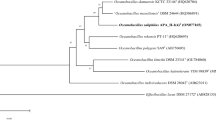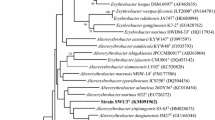Abstract
A thermo-acidophilic bacterium, designated strain ACK006T, was isolated from the soil of a hot spring at Tengchong in China. Cells were Gram-staining-positive, motile, catalase-positive and oxidase-negative, spore-forming rods. The isolate grew aerobically at 30–50°C (optimum at 45°C), pH 2.0–6.0 (optimum pH 3.2) and 0–5.0% (w/v) NaCl (optimum 1% NaCl). Phylogenetic analyses based on 16S rRNA gene sequences indicated that strain ACK006T belongs to the genus Alicyclobacillus with the sequence similarity of 92.3, 92.4, 92.5, and 92.8% to Alicyclobacillus cycloheptanicus SCHT, Alicyclobacillus ferrooxydans TC-34T, Alicyclobacillus contaminans 3-A191T and Alicyclobacillus disulfidooxidans SD-11T, respectively. Similarity to other species of the genus Alicyclobacillus was 90.3–92.8% and similarity to species of the genus Tumebacillus was 85.9–87.8%. The genomic DNA G+C content was 53.7 mol%. The predominant menaquinone was MK-7. Major fatty acids were ω-cycloheptane C18:0, iso-C17:0 and anteiso-C17:0. The cell-wall peptidoglycan was the A1γ type; containing meso-diaminopimelic acid as the diagnostic diamino acid. On the basis of polyphasic analysis from this study, strain ACK006T represents a novel species of the genus Alicyclobacillus for which the name Alicyclobacillus tengchongensis sp. nov. is proposed. The type strain is ACK006T (=KCTC 33022T =DSM 25924T).
Similar content being viewed by others
References
Collins, M.D. and Jones, D. 1981. Distribution of isoprenoid quinone structural types in bacteria and their taxonomic implications. Microbiol. Rev. 45, 316–354.
Deinhard, G., Blanz, P., Poralla, K., and Alton, E. 1987. Bacillus acidoterrestris sp. nov., a new thermotolerant acidophile isolated from different soils. Syst. Appl. Microbiol. 10, 47–53.
DeLong, E.F. 1992. Archaea in coastal marine environments. Proc. Natl. Acad. Sci. USA 89, 5685–5689.
Euzéby, J.P. 2013. List of Prokaryotic names with Standing in Nomenclature. http://www.bacterio.cict.fr.
Felsenstein, J. 1981. Evolutionary trees from DNA sequences: a maximum likelihood approach. J. Mol. Evol. 17, 368–376.
Felsenstein, J. 1985. Confidence limit on phylogenies: an approach using the bootstrap. Evolution 39, 783–791.
Fitch, W.M. 1972. Toward defining the course of evolution: minimum change for a specific tree topology. Syst. Zool. 20, 406–416.
Goto, K., Mochida, K., Asahara, M., Suzuki, M., Kasai, H., and Yokota, K. 2003. Alicyclobacillus pomorum sp. nov., a novel thermoacidophilic, endospore-forming bacterium that does not possess ω-alicyclic fatty acids, and emended description of the genus Alicyclobacillus. Int. J. Syst. Evol. Microbiol. 53, 1537–1544.
Goto, K., Mochida, K., Kato, Y., Asahara, M., Fujita, R., An, S.Y., Kasai, H., and Yokota, A. 2007. Proposal of six species of moderately thermophilic, acidophilic, endospore-forming bacteria: Alicyclobacillus contaminans sp. nov., Alicyclobacillus fastidiosus sp. nov., Alicyclobacillus kakegawensis sp. nov., Alicyclobacillus macrosporangiidus sp. nov., Alicyclobacillus sacchari sp. nov. and Alicyclobacillus shizuokensis sp. nov. Int. J. Syst. Evol. Microbiol. 57, 1276–1285.
Imperio, T., Viti, C., and Marri, L. 2008. Alicyclobacillus pohliae sp. nov., a thermophilic, endospore-forming bacterium isolated from geothermal soil of the north-west slope of Mount Melbourne (Antarctica). Int. J. Syst. Evol. Microbiol. 58, 221–225.
Jiang, C.Y., Liu, Y., Liu, Y.Y., You, X.Y., Guo, X., and Liu, S.J. 2008. Alicyclobacillus ferrooxydans sp. nov., a ferrous-oxidizing bacterium from solfataric soil. Int. J. Syst. Evol. Microbiol. 58, 2898–2903.
Johnson, D.B. 1995. Selective solid media for isolating and enumerating acidophilic bacteria. J. Microbiol. Methods 23, 205–218.
Karavaiko, G.I., Bogdanova, T.I., Tourova, T.P., Kondrat’eva, T.F., Tsaplina, I.A., Egorova, M.A., Krasil’nikova, E.N., and Zakharchuk, L.M. 2005. Reclassification of ‘Sulfobacillus thermosulfidooxidans subsp. thermotolerans’ strain K1 as Alicyclobacillus tolerans sp. nov. and Sulfobacillus disulfidooxidans Dufresne et al. 1996 as Alicyclobacillus disulfidooxidans comb. nov., and emended description of the genus Alicyclobacillus. Int. J. Syst. Evol. Microbiol. 55, 941–947.
Kim, O.S., Cho, Y.J., Lee, K., Yoon, S.H., Kim, M., Na, H., Park, S.C., Jeon, Y.S., Lee, J.H., Yi, H., Won, S., and Chun, J. 2012. Introducing EzTaxon-e: a prokaryotic 16S rRNA gene sequence database with phylotypes that represent uncultured species. Int. J. Syst. Evol. Microbiol. 62, 716–721.
Kimura, M. 1980. A simple method for estimating evolutionary rates of base substitutions through comparative studies of nucleotide sequences. J. Mol. Evol. 16, 111–120.
Larkin, M.A., Blackshields, G., Brown, N.P., Chenna, R., McGettigan, P.A., McWilliam, H., Valentin, F., Wallace, I.M., Wilm, A., and other authors. 2007. Clustal W and Clustal X version 2.0. Bioinformatics 23, 2947–2948.
Matsubara, H., Goto, K., Matsumura, T., Mochida, K., Iwaki, M., Niwa, M., and Yamasato, K. 2002. Alicyclobacillus acidiphilus sp. nov., a novel thermo-acidophilic, ω-alicyclic fatty acid-containing bacterium isolated from acidic beverages. Int. J. Syst. Evol. Microbiol. 52, 1681–1685.
Mesbah, M., Premachandran, U., and Whitman, W.B. 1989. Precise measurement of the G+C content of deoxyribonucleic acid by high performance liquid chromatography. Int. J. Syst. Bacteriol. 39, 159–167.
Murray, R.G.E., Doetsch, R.N., and Robinow, F. 1994. Determinative and cytological light microscopy. In Methods for General and Molecular Bacteriology, pp. 21–41. In Gerhardt, P., Murray, R.G.E., Wood, W.A., and Krieg, N.R. (eds.). American Society for Microbiology, Washington, D.C., USA.
Norris, P.R., Clark, D.A., and Owen, J.P. 1996. Characteristics of Sulfobacillus acidophilus sp. nov. and other moderately thermophilic mineral-sulphide-oxidizing bacteria. Microbiology 142, 775–783.
Saito, H. and Miura, K. 1963. Preparation of transforming deoxy-ribonucleic acid by phenol treatment. Biochem. Biophys. Acta 72, 619–629.
Saitou, N. and Nei, M. 1987. The neighbor-joining method: a new method for reconstructing phylogenetic trees. Mol. Biol. Evol. 4, 406–425.
Silverman, M.P. and Lundgren, D.G. 1959. Studies of the chemoautotrophic iron bacterium Ferrobacillus ferrooxidans. I. An improved medium and a harvesting procedure for securing high cell yields. J. Bacteriol. 77, 642–647.
Simbahan, J., Drijber, R., and Blum, P. 2004. Alicyclobacillus vulcanalis sp. nov., a thermophilic, acidophilic bacterium isolated from Coso Hot Spring, California, USA. Int. J. Syst. Evol. Microbiol. 54, 1703–1707.
Smibert, R.M. and Krieg, N.R. 1994. Phenotypic characterization. In Methods for General and Molecular Bacteriology, pp. 607–654. In Gerhardt, P., Murray, R.G.E., Wood, W.A., and Krieg, N.R. (eds.). American Society for Microbiology, Washington, D.C., USA.
Tamura, K., Peterson, D., Peterson, N., Stecher, G., Nei, M., and Kumar, S. 2011. MEGA5: Molecular evolutionary genetics analysis using maximum likelihood, evolutionary distance, and maximum parsimony methods. Mol. Biol. Evol. 28, 2731–2739.
Wisotzkey, J.D., Jurtshuk, P. Jr., Fox, G.E., Deinhard, G., and Poralla, K. 1992. Comparative sequence analyses on the 16S rRNA (rDNA) of Bacillus acidocaldarius, Bacillus acidoterrestris, and Bacillus cycloheptanicus and proposal for creation of a new genus, Alicyclobacillus gen. nov. Int. J. Syst. Bacteriol. 42, 263–269.
Author information
Authors and Affiliations
Corresponding author
Additional information
Supplemental material for this article may be found at http://www.springerlink.com/content/120956.
The GenBank/EMBL/DDBJ accession numbers for the 16S rRNA gene sequence of strain ACK006T is KF772795.
Electronic supplementary material
Rights and permissions
About this article
Cite this article
Kim, M.G., Lee, JC., Park, DJ. et al. Alicyclobacillus tengchongensis sp. nov., a thermo-acidophilic bacterium isolated from hot spring soil. J Microbiol. 52, 884–889 (2014). https://doi.org/10.1007/s12275-014-3625-z
Received:
Revised:
Accepted:
Published:
Issue Date:
DOI: https://doi.org/10.1007/s12275-014-3625-z




